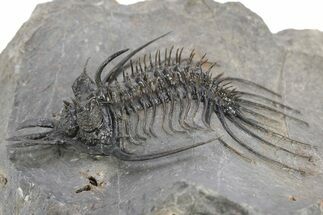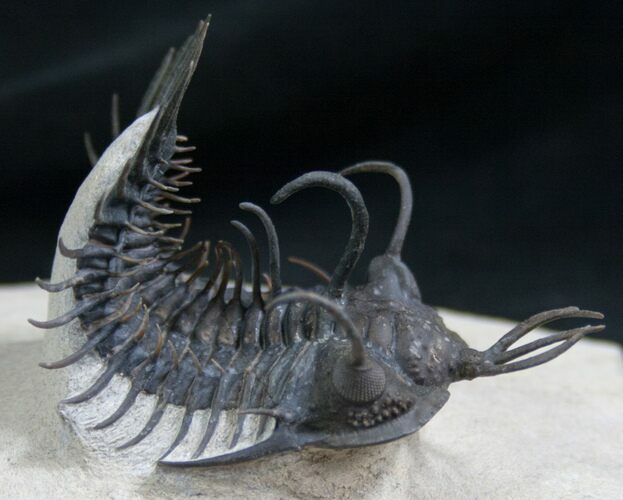This Specimen has been sold.
Beautifully Prepared Walliserops Hammi Trilobite
This is a spectacularly prepared specimen of the trilobite Walliserops hammi, often referred to at the "short trident" Walliserops. This specimen would be over 3 inches long if fully oustretched, the preservation and the preparation are SPECTACULAR. There is over 40, natural free-standing spines on this specimen and the matrix has even been removed from underneath the pygidial (tail) spines so they spread out like a fan. Just check out the detail in the eye facets. Only the most skilled preparators in the world can do this quality of work and more the 40 hours of labor likely went into the preparation of this trilobite.
There is some speculation that the long and short forked species may actually just represent sexual dimorphism within the type of trilobite. There also appears to be some substantial differences with the short fork specimens that I have previously offered from Timrzit, Morocco.
The only restoration on this specimen is about half of the spine above the left I eye was reconstructed and a touchup at the base of the fork. The last photo in the series shows the specimen pre restoration with the restored areas highlighted.
This is the best specimen of this species I've yet to offer for sale on FossilEra.
There is some speculation that the long and short forked species may actually just represent sexual dimorphism within the type of trilobite. There also appears to be some substantial differences with the short fork specimens that I have previously offered from Timrzit, Morocco.
The only restoration on this specimen is about half of the spine above the left I eye was reconstructed and a touchup at the base of the fork. The last photo in the series shows the specimen pre restoration with the restored areas highlighted.
This is the best specimen of this species I've yet to offer for sale on FossilEra.
About Walliserops
The trilobite genus Walliserops is one of the most visually striking and iconic trilobites known, famous for its elaborate cranidial (head) ornamentation. These Devonian-aged trilobites lived approximately 390 million years ago and are found exclusively in the marine limestones of the Anti-Atlas Mountains of Morocco, particularly near Foum Zguid,
Walliserops belongs to the order Phacopida and the family Acastidae. It is best known for the distinctive trident-like projection extending from the front of its glabella (the central lobe of the head), a feature unmatched in any other trilobite. The function of this bizarre structure is still debated; some paleontologists suggest it may have played a role in mate recognition, species display, or even combat, akin to a rhinoceros horn. In addition to the trident, Walliserops trilobites often display long, curved genal spines and elaborately spined thoraxes, enhancing their alien-like appearance.
There are several described species within the genus, including Walliserops trifurcatus, W. hammii, and W. tridens, which differ slightly in the length, curvature, and orientation of the trident and other spines. These trilobites are highly sought after by collectors and researchers alike, both for their aesthetic appeal and the evolutionary questions they raise about morphological development and behavior in ancient arthropods.
Due to the complexity of their anatomy and the challenges of preparing specimens from hard limestone matrix, well-preserved Walliserops fossils require meticulous preparation, and many of the finest examples are partially or fully freed from the rock to showcase their dramatic three-dimensional form.
The trilobite genus Walliserops is one of the most visually striking and iconic trilobites known, famous for its elaborate cranidial (head) ornamentation. These Devonian-aged trilobites lived approximately 390 million years ago and are found exclusively in the marine limestones of the Anti-Atlas Mountains of Morocco, particularly near Foum Zguid,
Walliserops belongs to the order Phacopida and the family Acastidae. It is best known for the distinctive trident-like projection extending from the front of its glabella (the central lobe of the head), a feature unmatched in any other trilobite. The function of this bizarre structure is still debated; some paleontologists suggest it may have played a role in mate recognition, species display, or even combat, akin to a rhinoceros horn. In addition to the trident, Walliserops trilobites often display long, curved genal spines and elaborately spined thoraxes, enhancing their alien-like appearance.
There are several described species within the genus, including Walliserops trifurcatus, W. hammii, and W. tridens, which differ slightly in the length, curvature, and orientation of the trident and other spines. These trilobites are highly sought after by collectors and researchers alike, both for their aesthetic appeal and the evolutionary questions they raise about morphological development and behavior in ancient arthropods.
Due to the complexity of their anatomy and the challenges of preparing specimens from hard limestone matrix, well-preserved Walliserops fossils require meticulous preparation, and many of the finest examples are partially or fully freed from the rock to showcase their dramatic three-dimensional form.
SPECIES
Walliserops hammi
LOCATION
Foum Zguid, Morocco
SIZE
3" long if outstretched
CATEGORY
SUB CATEGORY
ITEM
#8145
We guarantee the authenticity of all of our specimens.
 Reviews
Reviews




















